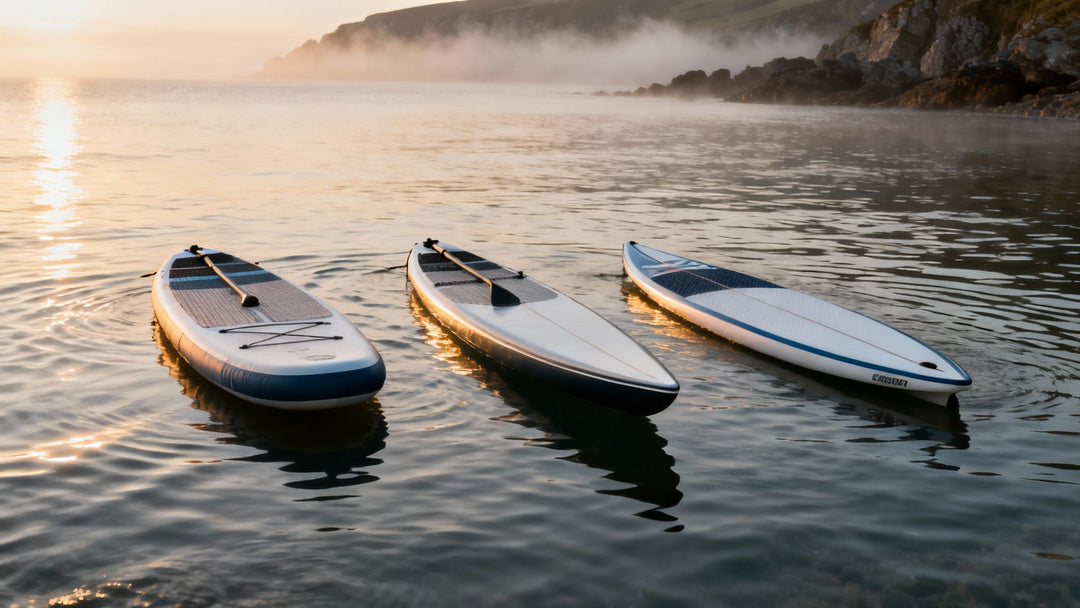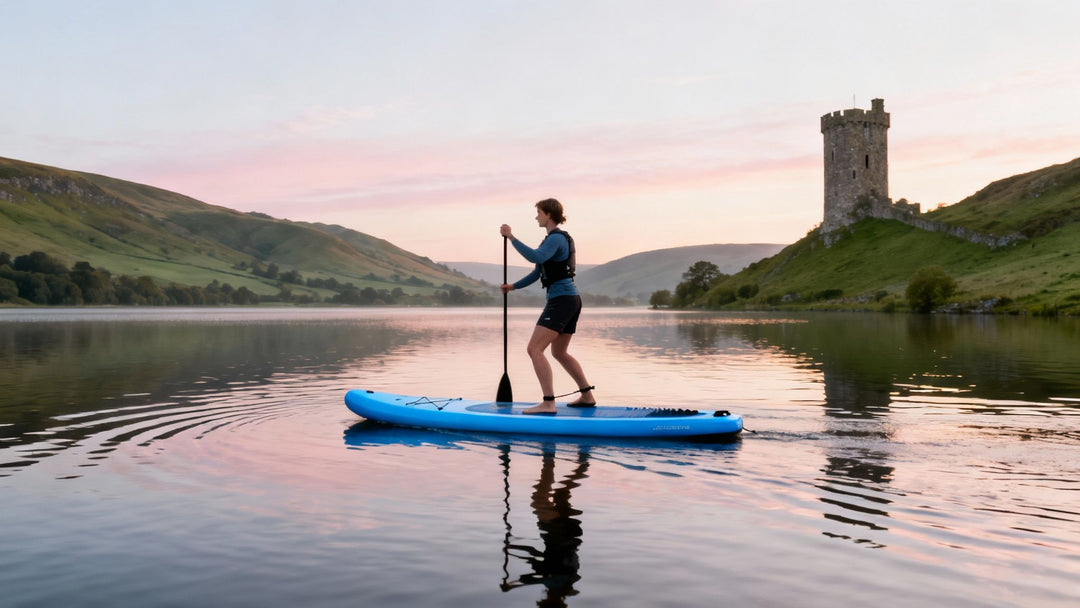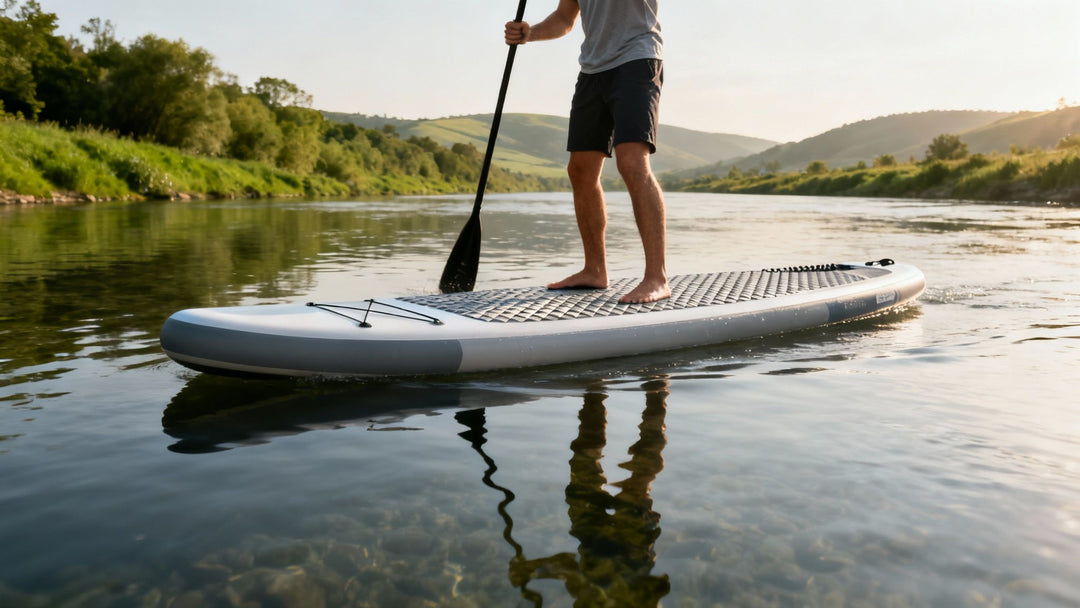Best Stand Up Paddle Boards for Beginners
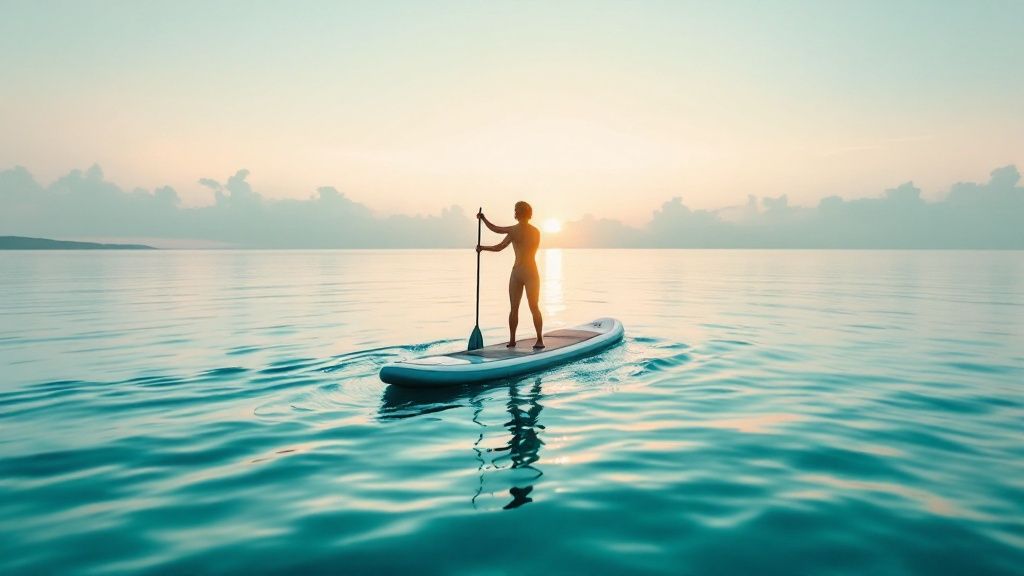
If you're looking for your first stand up paddle board, the number one thing to prioritise is stability. A wider, thicker board acts as a solid platform, making it much easier to find your balance. This simple choice can be the difference between a fantastic, confidence-boosting day on the water and a wobbly, frustrating struggle. For example, choosing a board that's 34 inches wide instead of 30 inches will feel noticeably more stable, letting you focus on your paddle stroke rather than just trying to stay upright.
Why Stand Up Paddle Boarding Is for Everyone
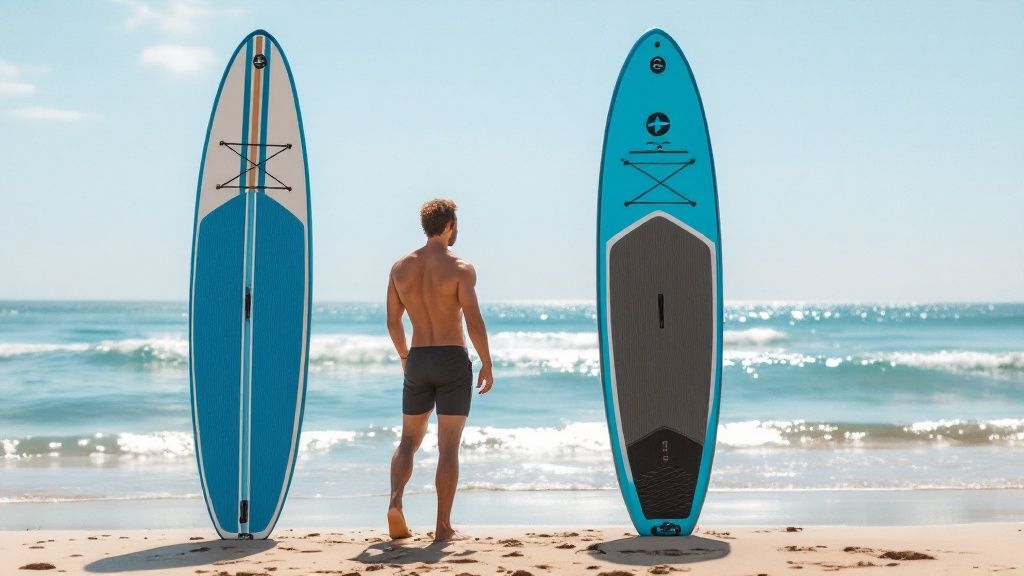
Welcome to the brilliant world of Stand Up Paddle Boarding (SUP). Forget any ideas you might have of pro athletes surfing massive waves; the reality is far more relaxed and accessible. If you can stand, you can learn to paddle board, which is exactly why it's become one of the most rewarding ways to get out on the water.
The real beauty of SUP lies in its gentle learning curve. Unlike other sports that require hours of practice just to get going, you can genuinely grasp the basics of paddle boarding in a single afternoon. This approachability is a massive reason for its explosion in popularity right across the United Kingdom.
In fact, British Canoeing called it the UK's fastest-growing watersport back in 2020, and local shops will tell you that a huge chunk of their customers—often more than a third—are complete newcomers. People are simply drawn to how easy and straightforward it is to get started.
Finding Your Balance from Day One
The biggest fear for most beginners is pretty simple: falling in. And that’s where choosing the right board makes all the difference. A purpose-built beginner board feels less like a wobbly plank and more like a steady, floating pontoon, giving you a solid base to build your confidence from.
It takes the wobble out of the equation and lets you focus on the simple joy of paddling and taking in the scenery.
For example, the Loco Amigo Air inflatable SUP was designed from the ground up with new paddlers in mind. Its generous width and high volume create an incredibly stable platform. This kind of design ensures your first session is all about enjoying yourself, not constantly fighting to stay upright.
Think of it this way: learning on a proper beginner board is like learning to ride a bike with stabilisers. It lets you master the core movements and gain confidence before you even think about moving on to bigger challenges.
More Than Just a Sport
Paddle boarding is also a fantastic, low-impact workout. It engages your core, back, and shoulders without putting any stress on your joints. More than that, it’s a chance to connect with nature, see familiar coastlines from a completely new angle, and just find a bit of calm.
Imagine gliding across a glassy lake at sunrise or exploring a quiet river—these are the experiences that get people hooked for life. A practical example is planning a gentle paddle down the River Wye; with a stable beginner board, you can focus on the stunning scenery and wildlife, making it a memorable adventure rather than a balancing act.
And once you've got the bug, you'll find there are so many other ways to enjoy the water. For a bit of inspiration, check out these Top 10 Water Activities in Vancouver for your next adventure. Consider this guide your first step towards discovering that freedom and fun for yourself.
Choosing Your First Board: Inflatable vs Hard
One of the first, and biggest, decisions you'll make when jumping into paddle boarding is whether to go for an inflatable board or a traditional hard one. This isn't just about picking a piece of kit; it's about choosing what fits your lifestyle. How you'll store it, transport it, and how it feels on the water all hang on this one choice.
For most newcomers here in the UK, especially if you're tight on space or live in a city, an inflatable stand up paddle board (or iSUP) is a total game-changer. Just imagine a full-size board that packs down into a backpack. You can sling it in the boot of your car, no roof rack needed, and tuck it away in a cupboard when you’re done. That’s the magic of an inflatable.
This sheer convenience is a massive reason they’ve exploded in popularity. In fact, all-round boards, which are mostly inflatables, make up a whopping 47.3% of global sales. It’s estimated that iSUPs are the first choice for over half of all UK beginners, helped by a friendly price point of around £400–£600 compared to the £800+ you'd often need for a rigid board.
The Rise of the Inflatable SUP
Don't mistake a modern inflatable for a flimsy pool toy. These things are seriously tough. They’re built with military-grade PVC using something called drop-stitch technology—basically, thousands of tiny threads connecting the top and bottom inside. When you pump them up to high pressure (usually 15-20 PSI), they become incredibly rigid and surprisingly solid underfoot.
A quality inflatable like our Loco Amigo Air is the perfect example. It's designed as the ultimate adventurer's package, giving you the freedom to explore without needing a van or a garage. A practical example of its convenience is deciding on a whim to drive to the Lake District after work; you just grab the backpack from your wardrobe, and you're good to go.
They’re also wonderfully durable. If you accidentally bump an inflatable against a rock or drop it on the car park floor, it’ll probably just bounce. This makes them far less intimidating if you're worried about damaging your new pride and joy.
This infographic gives you a quick rundown of the key dimensions to look for in a beginner board.
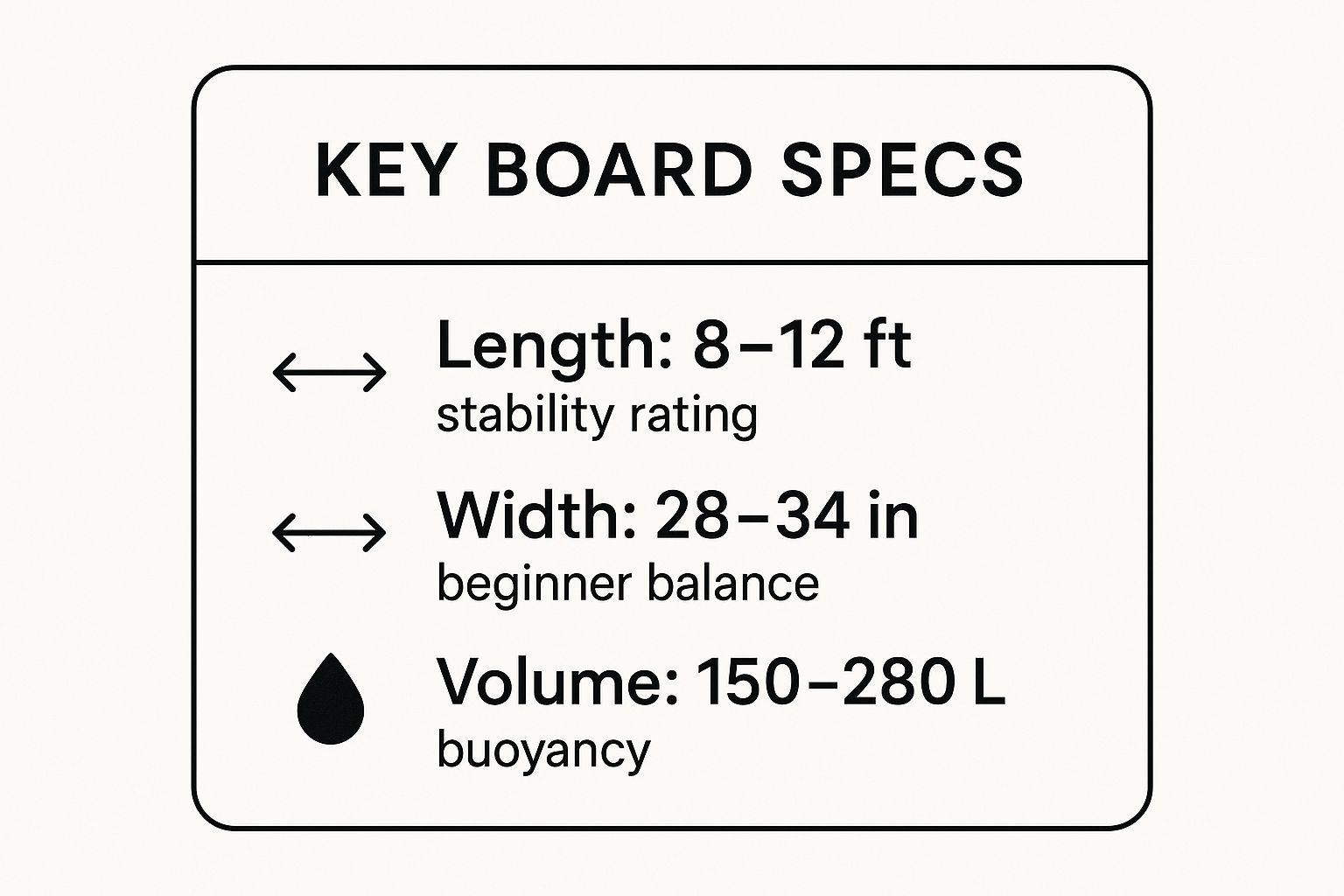
As you can see, a wider board gives you more stability, while having the right length and volume makes sure you're well supported on the water.
The Case for the Hard Board
So, with all that going for inflatables, why would anyone choose a hard board? It really boils down to one word: performance. Hard boards, typically made from materials like epoxy, fibreglass, and carbon fibre, simply offer better glide and speed.
Think of it like the difference between a mountain bike and a road bike. Both will get you from A to B, but the road bike is built for pure efficiency on smooth tarmac. A hard SUP cuts through the water with less resistance, which means every single paddle stroke takes you further, with less effort.
If you have plenty of storage—a garage or a big shed—and a way to get it to the water (like a roof rack), a hard board can be a fantastic investment. For anyone who knows they want to progress quickly, paddle longer distances, or maybe even dabble in a bit of SUP surfing, that performance edge is something you’ll really feel. A practical example is the Loco El Diablo hard board, which is perfect for someone looking to catch small waves at their local beach break, something that's much more challenging on an inflatable.
If you're leaning towards an inflatable but want more detail, check out our complete inflatable paddle board buyer's guide for more expert advice.
"For pure paddling performance, a hard board will always have the edge. It connects you to the water in a more direct way, offering better responsiveness and a smoother glide that is hard to replicate."
A Head-to-Head Comparison
To help make the decision a bit clearer, let's put them side-by-side. Your own lifestyle, where you'll keep it, and what you hope to do on the water will ultimately point you in the right direction.
Inflatable vs Hard SUP: A Beginner's Comparison
This table breaks down the key differences to help you figure out which board is the best fit for your paddling adventures.
| Feature | Inflatable SUP (e.g., Loco Amigo Air) | Hard SUP (e.g., Loco El Diablo) |
|---|---|---|
| Portability & Storage | Excellent. Deflates to fit in a large backpack. Easy to store in a flat or small house. | Poor. Requires a large vehicle with a roof rack for transport and a garage or shed for storage. |
| Durability | Very high. Resistant to dings, drops, and impacts. Ideal for rocky shorelines. | Moderate. Can be scratched or cracked if dropped or hit against hard objects. |
| Performance | Good. Modern iSUPs offer great rigidity and stability but have slightly more drag in the water. | Excellent. Offers superior glide, speed, and responsiveness. Better for surfing and racing. |
| Setup Time | 5-10 minutes to inflate with a pump. Packing away takes a similar amount of time. | Instant. Simply take it off the rack, attach the fin and leash, and you're ready to go. |
| Best For | Beginners with limited storage, travellers, and those paddling in various locations. | Paddlers with storage space, those prioritising speed and performance, and aspiring SUP surfers. |
When all is said and done, for the vast majority of people looking for their first stand up paddle board for beginners in the UK, an inflatable is the most practical and enjoyable way to start. It gets rid of the biggest hurdles—storage and transport—and delivers a brilliant experience on the water from day one.
How to Pick the Right SUP Size and Shape
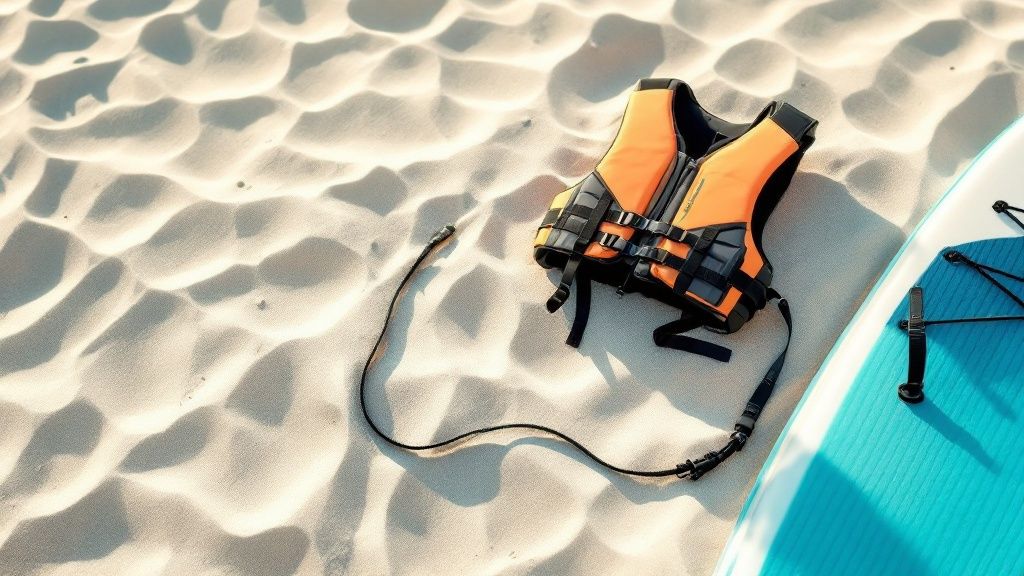
So, you've weighed up an inflatable versus a hard board. What's next? Getting the size and shape right. This isn't about getting bogged down in complex hydrodynamics; it's about making sure your first board feels like a stable, floating platform, not a wobbly tightrope.
Nailing this choice is absolutely critical. It’s the difference between loving your first few paddles and giving up in frustration. When you’re looking for your first stand up paddle board for beginners, the mission is simple: stability is king. The three numbers you need to care about are width, volume, and length. Think of them as the magic ingredients for a wobble-free ride.
Understanding SUP Shapes
Most beginner boards fall into a couple of key shapes, each designed for a slightly different adventure on the water.
- All-Round Boards: This is your reliable family hatchback. It’s versatile, dependable, and perfect for pretty much any situation you'll find yourself in as a newcomer. With a rounded nose and generous width (usually 32 inches or more), it offers rock-solid stability for paddling on canals, lakes, and calm seas. The Loco Amigo Air, for example, is a classic all-rounder, built to give new paddlers the confidence to stand up and feel secure from day one.
- Touring Boards: Now, think of this as the road bike of the SUP world. It has a pointed nose designed to cut through the water more cleanly, making it faster and better suited for covering longer distances. While it's a touch less stable than an all-rounder, a touring board is a great option for a confident beginner who wants to focus on fitness and exploration. For instance, the Loco Motion Air touring board is ideal for someone planning a 5km paddle along the coast and wanting to cover the distance more efficiently.
For your very first board, an all-round shape is almost always the smartest move. It's the most forgiving and gives you the solid foundation you need to master your balance and paddling technique without constantly feeling like you're about to take a dip.
Your Weight Matters Most
If there's one factor that trumps all others when choosing a board, it’s your body weight. A board needs enough volume—measured in litres (L)—to float you, your kit, and maybe even a dog. If the volume is too low for your weight, the board will sit low in the water, feel incredibly unstable, and be a real chore to paddle.
The golden rule for beginners is to go for plenty of volume. It's far better to have a board that's a bit too buoyant than one that isn't buoyant enough. Extra volume equals extra stability, which is exactly what you need when you’re starting out.
This is where you really need to listen to the manufacturer's recommendations. A board that’s a dream for a 60 kg rider will feel like a nightmare for someone who is 90 kg. For example, a 95kg rider would feel much more stable on the Loco Amigo Air 10'6'' x 34", which has over 300L of volume, compared to a smaller board with only 240L. To make it easier, we've put together a simple guide to help you find the right dimensions for your weight.
And if you want to get really granular, you can check out our detailed guide on how to choose the right paddle board for your height and weight.
Beginner SUP Sizing Guide by Rider Weight
To take the guesswork out of it, use this quick reference table. It’s designed to match your weight with the ideal board volume and width to give you the best possible stability.
| Rider Weight (kg) | Recommended Board Volume (Litres) | Recommended Board Width (Inches) |
|---|---|---|
| Under 65 kg | 170 - 220 L | 30" - 32" |
| 65 - 85 kg | 220 - 270 L | 32" - 33" |
| 85 - 105 kg | 270 - 320 L | 33" - 34" |
| Over 105 kg | 320+ L | 34"+ |
As you can see, the trend is clear: heavier riders need wider boards to maintain that all-important stability. By using these guidelines and opting for a versatile all-round shape, you're setting yourself up for success and countless fun days out on the water.
Essential Gear You Actually Need to Start
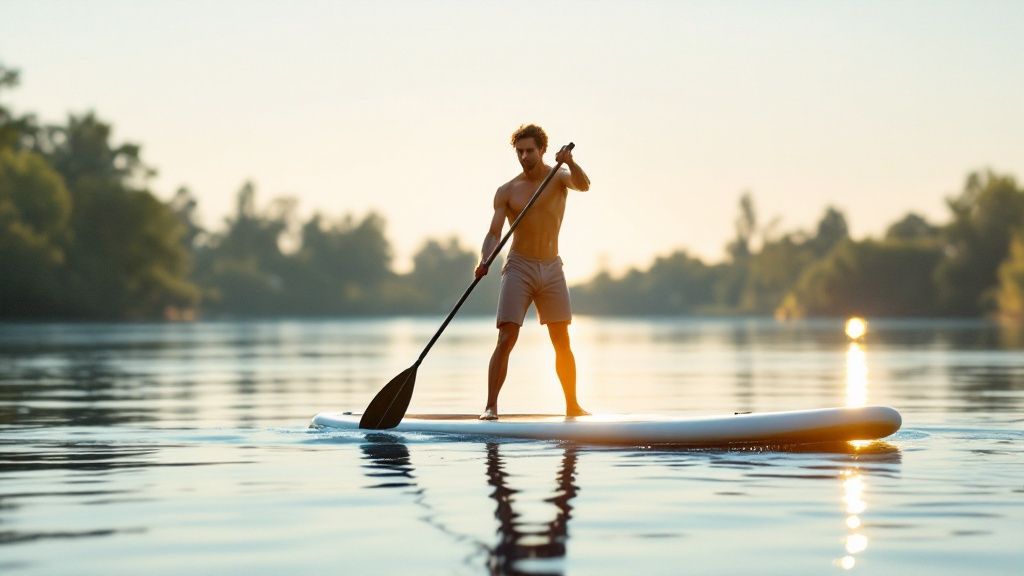
So, you've picked out the perfect board. What’s next? It's time to get kitted out with the gear that turns a good day on the water into a great one. You don't need a mountain of equipment, but there are a few items that are completely non-negotiable for staying safe and having fun.
Most beginner board packages, like the Loco Amigo Air package, will include a pump and a bag, which is great. But the three bits of kit you really need to get right are your paddle, your leash, and a personal flotation device (PFD). Nailing these choices is every bit as important as finding the right board.
Your Paddle: The Engine of Your Board
Think of your paddle as the engine for your stand up paddle board for beginners. It’s how you convert your effort into motion, gliding across the water. Paddles come in a few different materials, but for newcomers, the choice usually comes down to aluminium or carbon.
- Aluminium Paddles: These are the ones you’ll often find in beginner board packages. They’re built to last and won't break the bank, but they have some heft to them. You’ll definitely start to feel that extra weight in your arms and shoulders on longer trips.
- Carbon Paddles: A carbon or carbon-hybrid paddle is a game-changer. They are incredibly light, much stiffer, and way more efficient. That means every stroke you take pushes you further with less energy spent. Honestly, investing in a decent paddle early on is one of the smartest moves a new paddler can make. For example, upgrading to a Loco 50% Carbon Paddle can reduce fatigue, allowing you to paddle for an hour instead of 30 minutes before your arms get tired.
A lighter paddle means less fatigue and more time on the water, which makes every session more enjoyable.
The Leash: Your Lifeline to the Board
Your leash is, without a doubt, the single most important piece of safety kit you will ever own. It's a simple cord that tethers you to your board. If (or when) you fall in, it stops your board from being swept away by the wind or current. Your board is a giant float, and staying connected to it is absolutely crucial.
There are a couple of different types, each designed for specific conditions:
- Coiled Leash: This is your best friend for flat water paddling on lakes, canals, and calm coastal waters. The coil keeps the leash neatly on your board’s deck, so it doesn’t drag in the water and get snagged on weeds or branches. This is the type supplied in Loco iSUP packages.
- Straight Leash: This type is built for SUP surfing. In the waves, a straight leash is much safer because it won't spring back and send the board flying towards you after a wipeout.
A leash is your lifeline. Never, ever paddle without one. It's the simple habit that can turn a potentially dangerous situation into a minor inconvenience.
Essential Safety and Comfort Extras
Beyond the big three of board, paddle, and leash, a few other items will make a world of difference to your safety and comfort out there.
A Personal Flotation Device (PFD) is a must. This doesn't mean you need a bulky, old-school life jacket. Many paddlers go for streamlined buoyancy aids or even inflatable waist-belt PFDs. They give you total freedom of movement while providing that critical safety net. Always check local rules, as PFDs are mandatory on many UK waterways.
Protecting yourself from the sun is also vital. After all, you’ll be out in the open with light reflecting off the water. It’s worth checking out a UV protection guide for water activities to make sure you're covered during long sessions.
Finally, a dry bag is a cheap but incredibly useful bit of kit. It’s the perfect way to bring your keys, phone, and a few snacks along for the ride without worrying about them taking an accidental swim. A practical example is using a 5-litre dry bag clipped to your board's bungee cords to keep your car keys and phone safe while you explore.
Your First Time on the Water: A Step-by-Step Guide
Right, you’ve got your board, your paddle, and all the essential kit. The moment you’ve been waiting for is finally here – time to actually get on the water. This guide will walk you through the simple steps to launch like you know what you’re doing, stand up with confidence, and nail the basic paddle stroke that gets you moving.
Your first session is all about building a bit of confidence, so picking the right day is half the battle. You’re looking for a calm, sunny day with barely a whisper of wind. It’s also worth remembering that the UK beginner SUP market goes a bit mad in the summer, with 70–80% of new paddler sales happening between May and September. This means popular launch spots can get rammed during the school holidays, making those pre-launch safety checks even more vital. You can dig into more stats about the UK paddle board market on mordorintelligence.com.
Before your board even kisses the water, just take a minute. Stop and observe your surroundings. This simple habit is the foundation of staying safe every single time you go for a paddle.
Pre-Launch Safety Checks
First up, check the wind. A light breeze might feel like nothing on the land, but it'll have no trouble pushing you and your big board around on the water. The golden rule here is to always paddle out against the wind. It might feel like hard work at the start, but it means your journey back to shore will be much easier with the wind at your back, especially when you’re getting tired.
Next, if you're at the coast, have a quick look at the tides. A strong tide can act like a hidden river, pulling you along without you even noticing. Get a local tide app on your phone and check it before you head out so you know exactly what the water is planning to do.
Finally, and this is non-negotiable, make sure your leash is securely attached to both you (usually your ankle or calf) and your board. This is your lifeline if you take a tumble. Our guide covers more essential paddleboarding safety tips that every beginner needs to know.
Getting on Your Board
Carrying your board properly just makes life easier. Most boards, like our Loco models, have a carry handle right in the centre. Tuck the board under one arm, with the fin at the back and facing outwards, and let the handle take the weight.
- Walk out into knee-deep water. This is deep enough to stop your fin from scraping along the bottom.
- Lay your paddle across the board, just in front of where you're about to kneel.
- Place one knee on the board, just to one side of the handle, then bring the other knee up. You should now be kneeling comfortably in the centre of the board.
Just take a moment here. Get a feel for the board's balance by gently rocking from side to side. Why not paddle around on your knees for a few minutes? It’s a brilliant way to build confidence before you even think about getting to your feet.
Standing Up and Finding Your Balance
Once you feel steady on your knees, it’s time for the main event. The trick is to keep your movements smooth and your centre of gravity as low as possible.
- Step 1: From your kneeling position, place your hands flat on the board in front of you, about shoulder-width apart.
- Step 2: Bring one foot forward and plant it where your knee was. Then, do the same with the other foot. You should now be in a low squat, a bit like a baseball catcher.
- Step 3: With your feet shoulder-width apart and your knees nicely bent, slowly raise your chest and straighten up to a standing position. Keep your back straight and your core tight.
The biggest mistake beginners make is looking down at their feet. It will throw your balance off every single time. Instead, fix your gaze on the horizon. This simple trick is a game-changer for your stability.
The Perfect Paddle Stroke
Now that you’re up, it’s time to get going. A proper paddle stroke is all about your core, not your arms. If you try to power through with just your arms, you’ll be knackered in five minutes. Using your bigger core and back muscles gives you way more power and endurance.
To do a forward stroke on your right side:
- Place your right hand lower down the paddle shaft and your left hand right on top of the T-grip.
- Reach forward and plant the blade fully in the water. Think about planting it, not just dipping it.
- Pull the paddle back alongside your board. The power comes from rotating your torso while keeping your arms relatively straight.
- Once the paddle is level with your feet, lift it cleanly out of the water and get ready for the next stroke.
After a few strokes on one side, just swap your hand positions and paddle on the other. This will keep you moving in a straight line. And that's it – congratulations, you’re officially a paddle boarder.
Got Questions? We’ve Got Answers for New Paddlers
Jumping into stand up paddle boarding is a massive buzz, but it naturally comes with a few queries. This last section is all about tackling those common questions we hear from people just starting out. Getting some solid, straight-up answers will help you hit the water feeling ready and confident for that first adventure.
We'll cover everything from how long it takes to find your feet, to whether you can bring your four-legged first mate along for the ride. Let's get into the details that will swap that beginner uncertainty for proper on-the-water confidence.
How Long Does It Take to Learn to SUP?
This is probably the number one question on every beginner's mind. The brilliant news is that you can get the hang of the basics incredibly quickly. Most people are standing up and paddling around within their first hour on the water, especially if it’s a calm day and they're on a stable beginner board.
The real secret is to take your time. Start on your knees to get a feel for how the board balances. With a low centre of gravity, you feel super secure. Once you're comfortable paddling from your knees, making the move to standing up feels much more natural and way less intimidating.
While nailing advanced moves like pivot turns or catching waves takes practice, the fundamental skills are really accessible. This gentle learning curve is a massive part of what makes SUP so popular. A lesson from a certified instructor can seriously fast-track your progress and make sure you build good habits from day one.
What Is the Best Paddle Board Size for a Beginner?
Choosing the right size is all about stability, and that mostly comes down to your weight. As a beginner, your main goal is maximum stability, which you get from a board with plenty of width and volume. Generally, a newcomer should look for an all-round board that's between 10 to 11 feet long and, crucially, 32 to 34 inches wide.
Think of width as your stability insurance. A wider board is like a steady pontoon, giving you a forgiving platform to find your balance. Trading a little bit of speed for a lot more stability is a deal well worth making when you're starting out.
You also need to pay attention to the board’s volume, measured in litres. More volume means more buoyancy, which helps the board support your weight without any fuss. A board like the Loco Amigo Air is a perfect example; its dimensions are specifically designed for maximum stability, making it an ideal choice for most adults. It has the width and volume needed to keep you feeling secure.
Do I Need a Wetsuit for Paddle Boarding in the UK?
In a word, yes. We highly recommend a wetsuit for paddle boarding in the UK, even in the middle of summer. Our waters stay pretty cool all year round, and a wetsuit does two vital things: it gives you essential warmth if you take a tumble, and it protects you from wind chill, which can cool you down surprisingly fast.
On that rare, scorching hot day with zero wind, you might get away with shorts and a rash vest. But a good rule of thumb is to always dress for the water temperature, not the air temperature. It's a simple safety principle that can make all the difference.
For paddling in spring, autumn, or winter, a wetsuit isn't just a suggestion—it's a critical bit of safety gear. The right thickness will vary with the season, but having one in your kit is a must for anyone planning to paddle regularly in British waters.
Can I Take My Dog on My Paddle Board?
Absolutely! Paddle boarding with your dog can be an amazing experience for both of you. It does, however, take a bit of prep work to make sure everyone stays safe and has a good time.
You'll want a stable, wide board with a grippy deck pad that covers a large area. This gives your dog a secure spot to sit or lie down without sliding about.
- Canine Flotation Device: First things first, get a well-fitting life jacket for your dog. Even the best swimmers can get into trouble if they fall in unexpectedly.
- Gradual Introduction: Don't just chuck your dog on the board and shove off. Let them get used to it on dry land first. Once they're cool with it, move to very shallow water and keep the first few trips short, sweet, and full of positive vibes.
- Board Choice: A stable all-round board from the Loco range, with its generous width and volume, has the stability you need to comfortably handle an extra passenger, whether they have two legs or four.
Take these steps, and you can introduce your pup to paddling in a safe and fun way, setting you both up for countless shared adventures.
Ready to kickstart your paddle boarding journey with a board designed for success? At Loco Surfing, we've spent years perfecting boards that give beginners the ideal mix of stability, durability, and performance. Explore our range of beginner-friendly SUPs and find your perfect match today.


